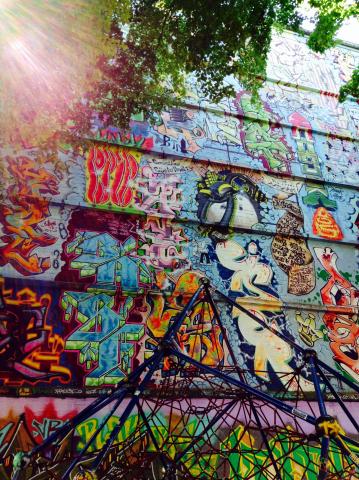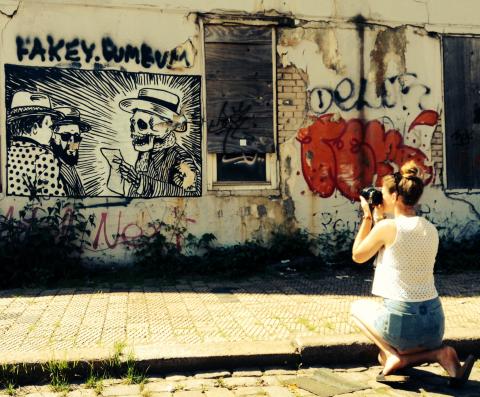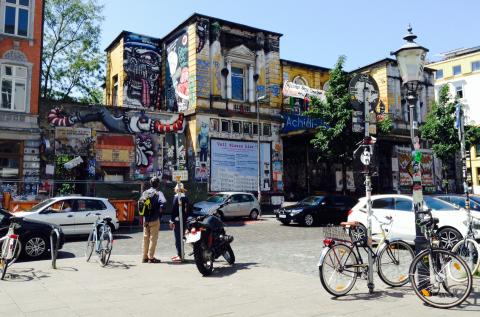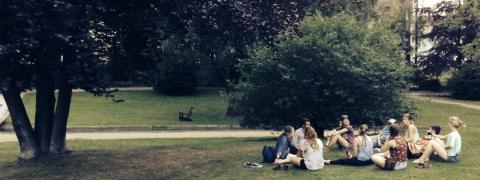
Schanzenviertel emerged as a colourful painting palette for passionate young artists, activists and protestors since around the 1980s. However, this city has been faced with numerous political, economic and social short comings. This area has remained resilient against the pressures of gentrification, authoritarian policing and high rates of crime.

Gentrification poses the greatest threat to a community such as this one. As housing is limited throughout Hamburg people are forced to move into less desirable neighbourhoods. As middle class families and young people move into these areas, they put a new financial and social pressure on the pre-existing community. This tends to drive housing prices up, and displaces people who can no longer afford to live in the area. In the case of Schanzenviertal, this is all true, but one of the specific issues the area faces is the oppression of street art.

Street art is one of the main cultural pillars supporting this community. Graffiti murals and memorials mark the walls of buildings all over the area reminding residents of the voices and people inhabiting the shared space. Young people searching for self expression within a bustling, run-down neighbourhood find empowerment and identity in their ever changing artwork. Some of the stories that our Alternative Tour Guide, Adam, shared with us explored these connections to place and urbanity through graffiti and street art. One of the stories that resonated with us was the history and transformations of the Rote Flora theatre. This building is one of the most left-wing places in all of Germany and has become a place of protest, a kind of social billboard for the area's deepest trials and tribulations. Through graffiti, local artists have used this building and it's history display their cultural perspectives with colourful words and powerful images.

Approaching this section of the reflection, we realize that our position as middle class young female Canadian tourists has an immense effect on how we conceive or perceive a place. We knew little about the area and were guided by one local resident. As a result of this we could not help but be persuaded by our tour guide's different biases of the place. Furthermore, even within our orientation group, there were mixed opinions of the place, resulting from our own backgrounds and experiences. For some, this place felt uncomfortable, grungy, disorienting, disorderly, un-community like, distracting or unattractive. However, for others members of our group it felt more expressive, colourful and vibrant. Our group also discussed that this place probably wouldn't be somewhere we would have explored on our own but that we were glad we had visited it and seen a variety of parts of Hamburg in comparison to HafenCity's development. We also considered where we come from and how that affects our perception of this place in terms of politics and regulations influencing our views. In Victoria, graffiti is illegal and is strictly prohibited under all circumstances unless done by commission or request under the homeowner's or business's consent. This perspective on the intense policing of alternative public art in Victoria has built a strong culture of anti-graffiti and associations of disgust that must be constantly hidden in certain areas.

Although first impressions can shift and shape artworks, they can also change with experiential knowledge and historical insights. This was true when we met with our tour guide, Adam, and learned about the background and purpose of the graffiti and the messages it had to share with community.
Interestingly enough, visiting this place inspired us to muse on more questions about Victoria's public street art culture...Are there places in our hometowns, or in Victoria, that showcase or promote legal street art spaces for graffiti artists? And if not, how might we find a wall or building in Victoria that could legally support this kind of creative free expression? How could this kind of street art actually act as a tool to inspire, ameliorate and build stronger senses of community in some of the more socially troubled areas of Esquimalt or Vic West? All of these questions demand that we look deeper into our own home places and search for new place-making spaces for improved social sustainability and community environments. Exploring the ways in which this place, Schanze, has made each of us feel about alternative and different kinds of public spaces has been a learning experience in itself. Realizing that much of what makes us feel safe and comfortable in a place or not, is largely subjective and intimately tied to our individual histories, socio-economic positions, life experiences and particular values.


